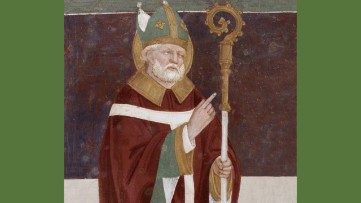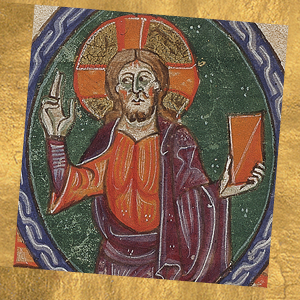St. Patrick, Bishop, Apostle of Ireland

A boy at prayer
Patrick was born in Roman Britain between 385 and 392, to a Christian family. At the age of fifteen or sixteen he was kidnapped by a handful of Irish pirates who took him with them to Northern Ireland and sold him as a slave. In his Confession, in which he tells the experience of those years, he writes, “Love for God and His fear grew in me, and so faith. In a single day I recited one hundred prayers, and at night almost as many. I prayed in the woods and mountains, even before the dawn. Neither the snow, nor the ice, nor the rain seemed to touch me.”
After six years of imprisonment, Patrick had in a dream, a premonition of freedom, and, obeying the vision he had as he slept, escaped surveillance and went the roughly 200 kilometers that separated him from the coast, on foot. There he was able to induce some sailors to have pity on him, who took him aboard their ship and carried him back to Britain where he could embrace his family once again.
A vision
A few years later, Patrick had another vision, which he also described in his Confession: “I saw a man coming to me as coming from Ireland; His name was Victoricus, he had some letters with him, and he handed me one. I read the first line: ‘The Voice of the Irish’. While I was reading, I seemed to hear the voice of the people living in the Forest of Voclutus [the place of his captivity] near the western sea, and their voices as one seemed to beg me, calling me 'young servant of God', and bidding us all walk together.”
This vision galvanized Patrick, who continued his studies and training, and was ordained to the presbyterate by Germanus, bishop of Auxerre.
His dream of evangelizing Ireland, however, was not yet close to coming to fruition. His candidacy for the episcopal ministry, in view of his mission to Ireland, met with opposition owing to a supposed lack of preparation due to the irregularity of his studies. This remained for a long time a burden for Patrick, who in the Confession admits: “I had not studied as others who have fed in equal measure of Law and Sacred Scripture, and from their infancy perfected their language. Instead, I had to learn a foreign language. Some accuse me of ignorance and have a stuttering speech, but it is actually written that stuttering tongues learn quickly to talk of peace.”
Bishop in Ireland
Finally, on an unknown date between 431 and 432, Patrick was consecrated Bishop of Ireland by Pope Celestine I and arrived in Slane on March 25, 432. The Bishop who had preceded him, Palladius, had returned to his country discouraged after less than two years of mission.
Patrick then found himself faced with countless difficulties: the chief of one of the Drude tribes tried to kill him, and for sixty days he was imprisoned, but despite the tribulations, Patrick persisted nearly forty years in his missionary work, converting thousands of Irish, introducing monastic life, and establishing the episcopal see in Armagh.
The clover
According to tradition, St. Patrick used to explain the mystery of the Trinity by showing the clover, in which three leaflets are joined at a single stem. The first written testimony of this dates back to 1726, though the tradition could have much older roots. The images of St. Patrick often portray him with a cross in one hand and a clover in the other. That is why the clover is now a symbol of St. Patrick's Day, which falls on March 17, the day of his death in 461 at Saul.
His remains were transported and buried in the cathedral of Down, which since then has been called Downpatrick.







